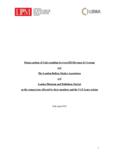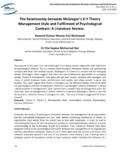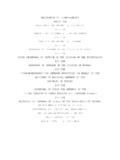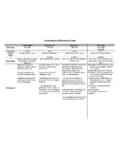Transcription of Towards an Understanding of Cultural Influence on …
1 Journal of International Business and Cultural Studies Towards an Understanding of Cultural Influence , Page 1 Towards an Understanding of Cultural Influence on the International Practice of Accounting Nigel Finch Macquarie University ABSTRACT The issue of Cultural Influence in explaining behaviour in social systems has been recognised for some time, however, its impact on accounting as a social system is a more recent field of study. This paper examines the theory of Cultural Influence on the international practice of accounting and critiques the contemporary research methodologies used to test this theory. Keywords: culture, accounting practice, international financial reporting, value dimensions Journal of International Business and Cultural Studies Towards an Understanding of Cultural Influence , Page 2 INTRODUCTION The issue of Cultural Influence in explaining behaviour in social systems has been recognised for some time, however, its impact on accounting as a social system is a more recent field of study.
2 This paper examines the theory of Cultural Influence on the international practice of accounting and critiques the contemporary research methodologies used to test this theory. MEASURING INTERNATIONAL CULTURE Environmental factors including legal systems, sources of external finance, taxation systems, representation by professional accounting bodies, historical inflation, economic and political events are used to help explain international differences in accounting practices (see, for example, Nobes and Parker, 2004, pp. 17-31). Another environmental factor that is seen as an influencer on international accounting practice and financial reporting is culture. Culture may be defined as the collective programming of the mind which distinguishes the members of one human group from another (Hofstede, 1980, p. 25). Each human group shares its own societal norms, consisting of common characteristics, such as a value system which is adopted by the majority of constituents.
3 Values are defined by Hofstede (1980, p. 19) as a broad tendency to prefer certain states of affairs over others . It is these definitions that have been widely adopted in accounting research to develop a Cultural framework to investigate international accounting differences. Hofstede s (1980) work on culture represents the most extensive research on national Cultural differences to date (Doupnik & Tsakumis, 2004). From attitude surveys collected from approximately 116,000 IBM employees across 39 countries, Hofstede identified four underlying value dimensions along which each country can be positioned. These societal values are: individualism versus collectivism; large versus small power distance; strong versus weak uncertainly avoidance, and; masculinity versus femininity. Across these dimensions, Hofstede s framework provides quantitative measures for each of the sample countries.
4 This broad sample of quantitative data has attracted many researchers studying cross- Cultural differences because the measures are seen as reliable for use as independent variables in statistical analysis. Some of these empirical studies will be examined later in this paper. THE IMPACT OF CULTURE IN ACCOUNTING From the literature and practice, Gray (1988) identified four accounting value dimensions that can be used to define a country s accounting (sub)culture: professionalism versus statutory control; uniformity versus conformity; conservatism versus optimism, and; secrecy versus transparency. The first two dimensions relate to authority and enforcement of accounting practice at a country level, and the second two relate to the measurement and disclosure of accounting information at a country level. Gray (1988) extends Hofstede s model by overlaying accounting values and systems and their links to societal values and institutional norms.
5 Gray posits that accountants value systems are related to and derived from the unique societal values in each country. Essentially, accounting values, in turn, affect accounting systems, therefore Cultural factors directly Influence the development of accounting and financial reporting systems at a country level (Doupnik & Tsakumis, 2004). Journal of International Business and Cultural Studies Towards an Understanding of Cultural Influence , Page 3 Gray introduced four propositions that hypothesise relationships between Hofstede s Cultural dimensions and his accounting value dimensions. Gray argues that shared Cultural values within a country lead to shared accounting values, which in turn influences the nature of a nation s accounting system (Doupnik & Tsakumis, 2004). Gray never operationalised the hypothesis or conducted empirical tests to support his framework, rather this has been left to other accounting researches to prove its validity and this is the focus of the next section.
6 EMPIRICAL TESTS OF THE HOFSTEDE GRAY FRAMEWORK There have been several contributions in the literature attempting to extend or refine the Hofstede Gray framework in Understanding the Influence of culture on accounting ( , Perera 1989; Fechner and Kilgore 1994; Baydoun and Willett 1995). Chanchani and MacGregor (1999) have examined the literature focused on the conceptual and theoretical issues of the Hofstede Gray model, while Doupnik & Tsakumis (2004) investigated the literature concerning the empirical testing of the theory relating culture to global diversity in financial reporting. Doupnik & Tsakumis (2004) attempted to determine whether the Gray (1988) framework had been subjected to adequate empirical inquiry so as to prove its validity, and summarised the research methodologies employed to test the theory by looking at: country level tests; studies testing all four hypotheses; studies testing one hypotheses only, and; testing at an individual level only (rather than a collective level).
7 Eddie (1990) provided the first empirical test of Gray s framework, testing all four hypotheses. The research methodology to test the theory constructed an index of accounting values for thirteen Asian-pacific countries and then correlated them with Hofsteded s Cultural dimensions. Encouragingly, the predicted signs of association were confirmed, however, the accounting value constructs and their method of measurement were not rigorous and had no independent validation, and as such these findings were quickly dismissed. Salter and Niswander (1995) used regression analysis to test Gray s hypotheses holding Hofstede s Cultural dimensions as the independent variables. Based on data from twenty-nine countries, Salter and Niswander (1995) found that while Gray s (1988) model has a significant explanatory power in terms of differential financial reporting practices, it is relatively weak in explaining professional and regulatory structures from a Cultural base.
8 According to their results, Salter and Niswander (1995) found a strong and positive correlation between uncertainty avoidance and professionalism indicating that the higher the country ranks in terms of uncertainty avoidance, the more likely it is to rank higher in professionalism. Second, uniformity was found to be significantly positively related to uncertainty avoidance and significantly negatively related to masculinity. These results demonstrated that conservatism was significantly positively related to uncertainty avoidance and significantly negatively related to masculinity, suggesting that the higher a country ranks in terms of uncertainty avoidance and the lower it ranks in terms of masculinity, the more likely it is to rank highly in conservatism. Finally, secrecy was found to be significantly positively related to uncertainty avoidance and significantly negatively related to individualism.
9 Gray hypothesised between Cultural dimensions and accounting values, suggesting that only some elements of Gray s theory were valid. Sudarwan and Fogarty (1996) independently developed their own measure of Cultural values abandoning the Hofstede (1980) index score. Their research methodology used structural equation modelling to test Gray s hypotheses against a longitudinal study of a single country, Indonesia. The results of the study demonstrated a significant positive relationship between power distance and both conservatism and uniformity, indicating that change in power distance is related to the change in accounting values in the Indonesian Journal of International Business and Cultural Studies Towards an Understanding of Cultural Influence , Page 4 context. Second, the results revealed a significant positive relationship between uncertainty avoidance and uniformity and uncertainty avoidance and conservatism.
10 However, uncertainty avoidance was significantly negatively associated with more secretive accounting practice. According to results, individualism was found to be significantly positively associated with professionalism and conservatism in accounting practice. Finally, secrecy was found to be significantly negatively associated with individualism, suggesting that a decreasing level of individualism is associated with the increasing trend of secrecy of accounting practice in Indonesian society. Overall, the results of the study support only four of the Gray s 13 hypotheses, suggesting a general lack of support for the framework. Moving away from testing all hypotheses, Gray and Vint (1995) tested only one dimension of Gray s (1988) hypothesis; that of secrecy. The attitudes of local partners of an international accounting firm were surveyed to understand secrecy with respect to disclosure practices.

















